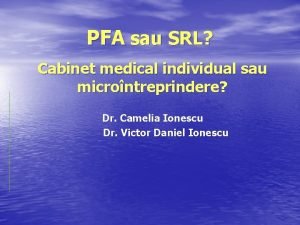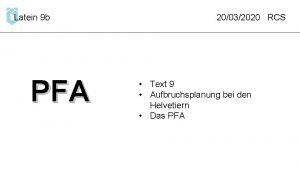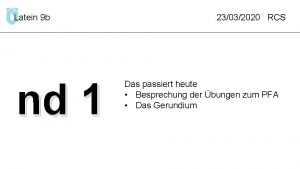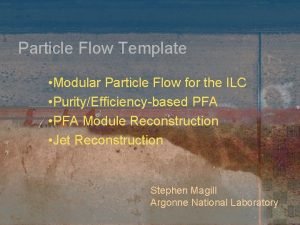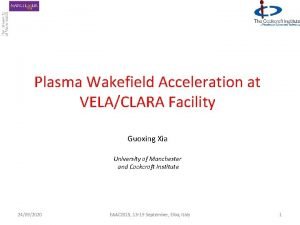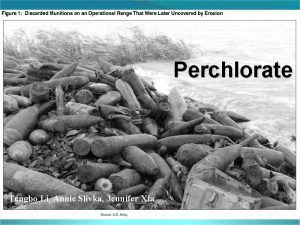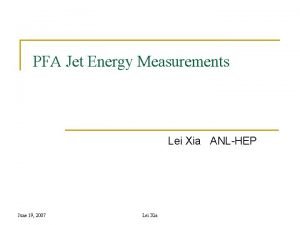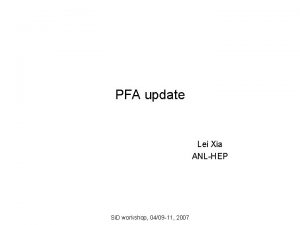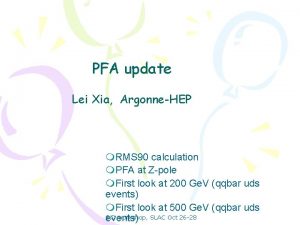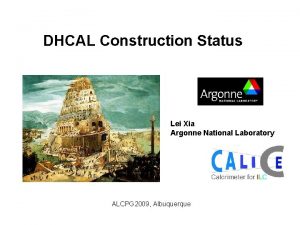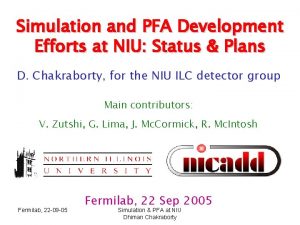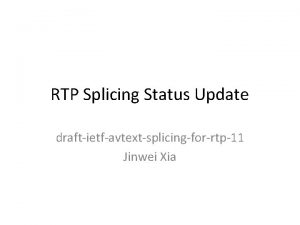Status of Si D PFA Development Lei Xia













- Slides: 13

Status of Si. D PFA Development Lei Xia (ANL – HEP) What tools do we need n Where are we now n Future plan n

Groups contributing to Si. D PFA development SLAC + ANL (I) Norman, Ron, …+Steve, Steve IOWA Mat Charles NIU ANL (II) Dhiman, Guilherme, Vishnu Lei Xia And many other groups (Fermilab, Colorado, Kansas, Tracking groups, … ) July 23, 2006 Si. D Concept Meeting

As a reference point: Pandora. PFA LDC: Pandora. PFA • Pandora. PFA is an European effort on PFA development • Results are based on LDC concept • Currently, it gives the best Z-pole performance Mark Thomson University of Cambridge ‘Current’ performance of Pandora. PFA (as of 06/15/2006) July 23, 2006 Si. D Concept Meeting

Tools needed for detector optimization: I n Goal: n 30%/sqrt(E) jet energy resolution PFA n n We need this jet energy resolution for ZH, ttbar, ZHH… @ 500 – 1000 Ge. V In other words, need 30%/sqrt(E) resolution for jet energy range: 45 – 250 Ge. V / jet PFA Detector optimization Tools (I): Particle Flow Algorithm n A complete PFA, with all algorithms implemented n n n Good performance for Z-pole di-jet events n n n Calibration, Track finding, Clustering algorithm, Photon identification Charged hadron id (track-cluster matching), neutral hadron id/fragment id Demonstrate 30%/sqrt(E) jet energy resolution at E = 91 Ge. V Have good understanding of all algorithms, source of the ‘confusion term’, etc. Understand PFA performance for jet energy range 45 – 250 Ge. V / jet n n Can use di-jet events at higher Ecm to do this study For PFA at high energy, may need quite different approach from what we have at Z-pole Pandora. PFA: LDC 00 e+e− uds pair using PFA optimized at Z-pole (Taken from Mark Thomson’s talk) July 23, 2006 Si. D Concept Meeting

Tools needed for detector optimization: I n Tools (I): Particle Flow Algorithm (continue…) n Understand PFA performance for multi-jet/complicated final states n n July 23, 2006 Demonstrate jet energy resolution for these final states Understand the effect from jet algorithm, neutrinos, energy leaks, etc. Si. D Concept Meeting

Tools needed for detector optimization: II n Tools (II): Optimization Procedure of PFA n n PFA must come with the capability to be optimized for different final states and detector configurations We need to assess the performance of different detector configurations with their optimal PFA – We want to compare the difference of detectors, not PFAs A ‘bad’ example: again, from Pendora. PFA/ LDC Related to non-optimal PFA? July 23, 2006 (Taken from Mark Thomson’s talk) Si. D Concept Meeting

Tools needed for detector optimization: III n Tools (III): PFA performance bench mark n A lot of ‘figure of merit’ has been used, we can hardly compare one with another n n n Same result can look very different under different ‘figure of merit’ These ‘figure of merit’ have very different ‘tolerance’ on tails of distributions Commonly used ‘figure of merit’ n 2 -Gaussian fit (North America) n n 3 -Gaussian fit (Europe) n n n (central, fraction), (L, fraction), (R, fraction) σ(narrow) ~ RMS(75) (fraction ~60%) For example: W and Z separation (the famous blue plot!) Or just RMS ? Example: 2 G fit n σ(narrow) ~ σ(central) frac(2 G) ≠ frac(3 G) RMS of the smallest region containing 90% of events (Europe) RMS(90) Equivalent pure Gaussian, which gives same physics performance as your PFA n n (narrow, fraction), (broad, fraction) Example: 3 G fit Example: RMS(90) Which PFA performance bench mark can reflect our physics need? n If we don’t require pure Gaussian or RMS, then 30%/sqrt(E) is not a complete measure yet n n July 23, 2006 n How much ‘tail component’ can we tolerate? What is the impact of the ‘tail component’ on the physics results we are interested in? This is a question that can not / should not be answered by PFA guys alone Si. D Concept Meeting

Current status of PFA development SLAC +ANL(I) Iowa NIU ANL(II) Pandora -PFA We are (more than? ) half way there… July 23, 2006 Color code: Done Not touched In progress Si. D Concept Meeting

Current PFA performance at Z-pole (uds) (Ge. V) Si. D model 2 Gaussian All events Narrow Broad 2 Gaussian Barrel events* RMS(90) Narrow Broad All RMS Equivalent** Pure Gaussian Barrel All Barrel SLAC+ ANL(I) sidaug 05 3. 2 (59%) 9. 9 (41%) 7. 4 Iowa sidaug 05 4. 8 (61%) 10. 8 (39%) 7. 7 NIU sidaug 05 _tcmt 3. 9 (59%) 10. 6 (41%) 8. 1 ANL(II) sidaug 05 _np 3. 2 (59%) 10. 0 (41%) Pandora PFA GLD PFA LDC GLD 3. 4 (59%) 10. 4 (41%) 4. 9 4. 5 3. 2 2. 8 ~ 6. 0 2. 9 8. 1 7. 5 5. 2 5. 3 * Different groups give slightly different definitions for ‘barrel events’ ** Pure Gaussian that gives equivalent W, Z separation July 23, 2006 1. ‘Tail’ of distribution is very important 2. Z-pole performance of our PFAs is not good enough yet Si. D Concept Meeting

Future plan (I) n SLAC + ANL(I) n n Finish/optimize PFA performance at Z-pole Once understood Z-pole, start true detector optimization + multi-jet event at higher Ecm Construct detector optimization grid, try to isolate and vary a single variable at a time Iowa, NIU, ANL(II) n n Continue to optimize PFA performance at Z-pole, make sure it delivers required jet energy resolution Study PFA performance with complicate final states (multi-jet) at high Ecm, and make sure PFA works and gets good jet energy resolution Make sure the PFA is flexible enough to be tuned to deliver optimal resolution for different detector designs Start detector optimization after all the above is achieved July 23, 2006 Si. D Concept Meeting

Future plan (II) n ALL n All efforts will adapt the PFA template to make PFA components interchangeable n n Encourage sharing code, algorithm and design ideas n n PFA template is a set of conventions that defines the general structure and interface of a particle flow algorithm, which makes PFA components as interchangeable as possible Source code should be publicly available for all efforts Need closer collaboration to avoid multiple parallel implementation of everything Need to implement more realistic tracking, digitization and tail catcher/muon system algorithm at some point PFA template: any new effort should start from here! n n https: //confluence. slac. stanford. edu/display/ilc/lcsim+PFA+guide A trivial worked example in CVS at n July 23, 2006 org. lcsim. plugin. web. examples. Trivial. PFA Si. D Concept Meeting

PFA development Timeline Z 0 -pole optimization Should be able to finish in a few months Hard to tell at this moment Di-jet, higher Ecm study • If PFA at high energy is just an extrapolation of Z-pole, then it should be done rather soon (but not likely…) • Otherwise, may have to take quite different approach and need a lot of effort >= 500 Ge. V, multiple jets • for example, clustering, instead of building up clusters, we may need to think hard on how to divide clusters into smaller pieces PFA optimization procedure n Optimize detector design n July 23, 2006 In the past , we might have underestimated the amount of effort needed to develop a good PFA Now we still need to do a lot to get PFA ready for detector optimization Si. D Concept Meeting

Summary n We made a lot of progress on PFA development, since last Si. D meeting n n We still need to do a lot to get PFA ready for detector optimization n n All algorithms are implemented (except track finding) Combined PFA performance at Z-pole kept improving PFA template in place Optimize Z-pole performance in the near future and achieve jet energy resolution goal at this energy Study more complicated final states at higher Ecm and show their optimal jet energy resolution Find an optimization procedure for PFA, in order to get the optimal performance for different detector designs Special thanks to Mat Charles, Guilherme Lima and Steve Magill, for their valuable input and comments July 23, 2006 Si. D Concept Meeting

